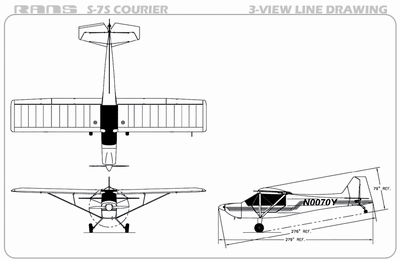Persistence of the Stall
On 06 October 2020, at approximately 15:83 PDT, a Rans S-7, registration N55893, stalled shortly after departing a three-thousand-foot grass runway near Spirit Lake, Idaho—a resort town approximately 27-nautical-miles northeast of Spokane, Washington’s Spokane International Airport (GEG). The accident claimed the life of the airplane’s 52-year-old Commercial pilot; injured the aircraft’s 57-year-old Airline Transport Pilot rated passenger; and substantially damaged the 2008-vintage Rans S-7.

In a subsequent interview, the downed aircraft’s passenger stated the airplane had remained in ground effect for a protracted period of time before climbing only above the trees surrounding the runway. So prolonged was the takeoff-roll that the passenger presumed, initially, that the flying pilot intended to abort the takeoff attempt. Nevertheless, the S-7’s flying pilot applied back-pressure to the aircraft’s control-stick and the aircraft broke ground.
Reaching an altitude of 75-feet AGL, the airplane’s left wing stalled, occasioning losses of lift and control commensurate with the S-7’s rapid descent and collision with terrain northeast of the runway.
Video analysis and GPS data indicated the experimental, light-sport, high-wing amphibious airplane’s left wing reached its critical angle of attack prior to the aircraft’s altitude loss. What’s more, sound spectrum analysis of the S-7’s Rotax 912-S engine indicated the mill was producing power at the time of the accident.
The aircraft, which was operated as a Part 91 personal flight, was under its maximum gross weight and within its center-of-gravity limits at the time of the accident. The circumstances of subject accident are consistent with the pilot’s exceedance of the airplane’s critical angle of attack during the flight’s initial-segment climb, which resulted in an aerodynamic stall and loss of control.
In an effort to determine the downed S-7’s estimated ground track, ground speed, altitude, orientation angles, and engine RPMs, the NTSB completed a performance study based on video footage of the takeoff and data recorded by an onboard Multi-Function Display (MFD) and GPS receiver.
The track data indicated the S-7’s ground speed increased from 41 to 52-knots after the aircraft became airborne, then decreased to 50-knots as it climbed above the surrounding tree-line. Video evidence revealed the S-7 reached a maximum altitude of 75-feet AGL approximately 22 seconds after becoming airborne, then entered a precipitous descent.
The angle of attack (AOA) of the S-7’s wing was derived from third-party video footage by evaluating the difference between the wing’s pitch angle and the aircraft’s flight path angle. Wind was not factored into the calculations insomuch as prevailing winds at the time of the accident were reported as calm.
The S-7’s wing stalled about 15 seconds after the aircraft became airborne, resulting in the large 19° rolling moment between 13.67 and 18 seconds. At 25 seconds into the flight, the S-7’s wing’s estimated angle of attack was 20°—a value in excess of the airfoil’s critical AOA.
The Rans S-7 impacted ground some 650-feet from the last data point.
Utilizing a temperature of 27° Celsius and the airport’s 2,500-MSL elevation, the density altitude at the time of the accident was computed to be approximately 4,453-feet MSL.

Sound spectrum analysis of the video revealed that at the time of the accident, the S-7’s engine speed was approximately 5,446 RPM—equating to about 94-percent of the one-hundred-horsepower Rotax 912-S engine’s 5,800 RPM redline. The engine and the three-bladed, composite, Warp Drive propeller to which it was mated were operating at the aforementioned RPMs even as the aircraft was losing altitude—a datum consistent with normal engine operation.
The flying pilot’s personal flight records were not recovered. On an October 2019 application for an FAA medical certificate, the pilot reported a total flight time of ten-thousand-hours. He purchased the Rans S-7 on 07 May 2000.
 ANN's Daily Aero-Term (05.10.24): Takeoff Roll
ANN's Daily Aero-Term (05.10.24): Takeoff Roll Aero-News: Quote of the Day (05.10.24)
Aero-News: Quote of the Day (05.10.24) Airborne 05.06.24: Gone West-Dick Rutan, ICON BK Update, SpaceX EVA Suit
Airborne 05.06.24: Gone West-Dick Rutan, ICON BK Update, SpaceX EVA Suit Airborne 05.03.24: Advanced Powerplant Solutions, PRA Runway Woes, Drone Racing
Airborne 05.03.24: Advanced Powerplant Solutions, PRA Runway Woes, Drone Racing Aero-News: Quote of the Day (05.11.24)
Aero-News: Quote of the Day (05.11.24)




